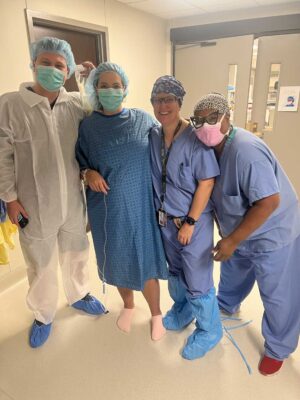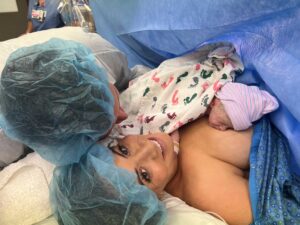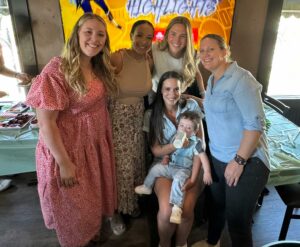Sara fought through recurrent miscarriages, surgery & a difficult pregnancy with preterm premature rupture of membrane (PPROM) in hopes of taking home her rainbow baby

Starting a family didn’t go as planned for CU Medicine OB-GYN East Denver patient Sara and her husband, Bobby. What they thought would be a straightforward path quickly turned into a series of loss and medical challenges. Like so many couples who struggle with fertility issues, they were unprepared for the roller coaster of emotions that lay ahead.
The heartbreak of recurrent miscarriage
In February 2022, Sara was overjoyed to learn she was pregnant for the first time. But she soon became concerned about some strange symptoms and quickly scheduled an appointment with Dr. Alicia Carranza. Dr. Carranza shared the disappointing news that Sara had experienced a chemical pregnancy, or a very early miscarriage. This loss marked the beginning of a long and complicated journey. Despite the emotional toll, she and Bobby remained hopeful and decided to try again shortly after.
By May, Sara was pregnant again, but her excitement was short-lived. After Dr. Daniel Jacobson detected poor embryo growth, he asked Sara to come back in June for a follow-up where she was diagnosed with a missed miscarriage, or a silent miscarriage. This occurs when the baby doesn’t develop or passes away in the womb and the mother’s body doesn’t physically miscarry it. Sara was scheduled for a D&C (dilation & curettage) procedure to avoid infection from the failed pregnancy. This allows the doctors to widen the cervix and scrape the lining of the uterus.
Sara contracted COVID, delaying the necessary treatment. Despite taking medication to clear the miscarriage, she experienced ongoing bleeding for two more months. Dr. Jacobson sought a second opinion from Dr. Emily Schneider, who recommended proceeding with the original plan to have Sara undergo a D&C. Sara was swiftly scheduled for the surgery with Dr. Schneider.
Dr. Schneider sat down with me and explained every detail of the surgery. It was the first time I had ever met her and she took 45 minutes to talk to me like a human being about women’s health and my procedure. I’ve never been able to talk to a doctor like that.”
D&C complications lead to a discovery & changed plans
The procedure was far more complex than anyone anticipated and ended up taking the teamwork of several providers to clear the miscarriage. Sara remained awake throughout the longer-than-expected, difficult process.
But something positive came from the more in-depth procedure. Dr. Schneider noticed what she thought might be a polyp inside Sara’s uterus that could have been preventing a successful pregnancy. This discovery led to a new plan.
A polyp procedure for pregnancy
In August a hysterosonogram confirmed a 1.5-inch polyp along Sara’s endometrium, which was surgically removed on September 16, 2022, by Drs. Jacobson and Schneider. Finally after the polyp removal, Sara and Bobby could focus on healing, both physically and emotionally.
It had been a difficult summer. The miscarriage from May hadn’t resolved until September, leaving Sara to manage both the physical and emotional weight for months. After the polyp surgery, the couple decided to take a break from trying to conceive and focus on their health.
Finding fertility after polyp surgery
By February 2023, Sara and Bobby felt ready to try again, and Sara became pregnant right away. She remained cautious and her anxiety lingered throughout the early weeks of pregnancy. Fortunately, Dr. Schneider was supportive and proactive with regular scans. Sara’s 20-week scan was completely normal, offering another moment of relief.
During the 24-week check-up Dr. Alison Patterson noticed the baby’s growth was slightly restricted. After further evaluation, everything appeared within the normal range, and Sara continued her pregnancy with guarded optimism.
Preeclampsia and an unexpected twist
At her 27-week gestational diabetes test, Dr. Schneider thought the baby’s growth restriction was a sign that Sara would soon develop full-fledged preeclampsia, and that the baby would come early. She advised Sara to cancel all upcoming travel plans and monitor her blood pressure closely, returning to the hospital immediately if she felt strange or her blood pressure was even slightly irregular.
Less than 24 hours later, Sara’s blood pressure spiked to 155/100. By the time she arrived at Rose Medical Center, it had risen to 180/100, confirming Dr. Schneider’s concerns. The following day she was diagnosed with early-stage preeclampsia. The doctors told her she would likely need to deliver within the week, even though her baby was only 28 weeks along and 26 weeks in size.
“At Dr. Schneider’s warning I had cancelled travel plans to fly out for a wedding and to say goodbye to a very dear friend who was passing,” says Sara. “It had been a jarring conversation, but I have to think that if I didn’t have a doctor paying close enough attention, I could have been on a plane and things would have gone a really different way.”
Getting past PPROM
Sara was given medication and her blood pressure stabilized, but a new complication emerged when her water broke unexpectedly just a few days later. This is called preterm premature rupture of the membranes (PPROM) and occurs this early in only 1%-3% of pregnancies. Every doctor she spoke to was very clear that she likely wouldn’t last to her delivery goal of week 34 before needing an emergency C-section.
“I tried to rest and remain calm,” says Sara. “By some miracle, my water resealed and I was allowed to continue the pregnancy with close monitoring.”
Stuck in the hospital, with help from friends

Bobby spent the next seven weeks sleeping on an air mattress in the hospital where the couple were surrounded by support. There wasn’t a day that went by where a provider from CU Medicine OB-GYN East Denver didn’t come by the room to visit and check on them.
Old friends came by and washed Sara’s clothes, brought Sara and Bobby food, and provided lots of laughter. New friends were also made with those who worked at the hospital. One of those new friends was Alem, a staff member at Rose Medical Center who regularly cleaned the couple’s room and still stays in touch, seeing Sara and Bobby regularly. Elaine, a traveling nurse, took the time to braid Sara’s hair when it was becoming matted from bedrest.
“If you are going to be stuck somewhere,” says Sara, “that is the place to do it and the people to be stuck with.”
A planned C-section for a premature birth
Against all odds, Sara managed to carry her baby until the 34-week mark. She chose to undergo a scheduled C-section on September 26, 2023, in hopes of having one thing she could control during her experience. Dr. Schneider, who had been a consistent presence throughout Sara’s care, made special arrangements so she could be the one to perform the surgery.
That morning, Sara received an uplifting text message from Dr. Sarah Peterson, and Dr. Jacobson stopped by the room to wish them good luck. Music was playing in the delivery room. Sara and Bobby surrounded themselves with all of the people they had gotten to know during their long stay in the hospital. Sara’s close friend Emily, who originally shared her due date, works at Rose Medical Center and got to be her nurse for the procedure. The delivery was smooth, and Micah was born. Their rainbow baby, which is what a baby born after a previous miscarriage is often called, weighed just over four pounds.
Life in the NICU

Micah spent almost five weeks in the neonatal intensive care unit (NICU), a challenging time for Sara and Bobby. Though the neonatology team gifted Sara with a brief moment of skin-to-skin contact immediately after his birth, she found it difficult to see him attached to machines and tubes. Thankfully, the medical team provided excellent care, and the couple felt supported during this critical period.
On October 27, Micah was able to go home on oxygen. Over the next few weeks, he gradually weaned off the oxygen, and Sara and Bobby could finally experience life with their “wireless baby.”
Reflecting on pain, polyps, preeclampsia, PPROM and a preemie

Now that Micah is home and thriving, Sara feels a sense of relief. Looking back on her journey, she recognizes how important it was to stay communicative and informed at every stage. She believes that being open about her miscarriages and talking about them with others has helped her to heal.
She didn’t know how many other women had experienced something similar until sharing her own story. She also believes that there is no shame in asking friends and family for support during trying times; this support was critical in surviving her 49-night hospital stay.
“It can be an overwhelming experience,” says Sara. “But having the right medical team and a strong support system makes all the difference.”
Micah, now a 1-year-old boy, is healthy, smiley and meeting his developmental milestones. Dr. Schneider, Nurse Emily, Alem and two OB-GYN residents, Drs. Liv Campbell and Gaby Fangman, all attended Micah’s first birthday celebration.
Micah is the happiest, easiest baby ever. Looking back, it feels like the NICU lasted 10 years but the last 11 months with Micah home feels like it has only lasted one day.”
